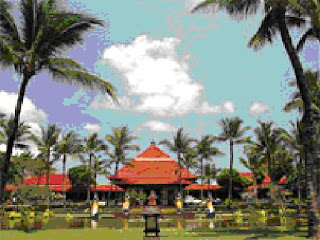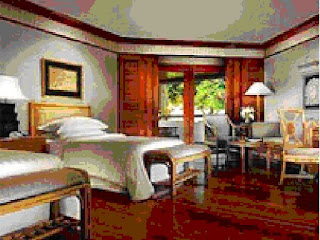I. KUTA, SEMINYAK, LEGIAN
1. Dining
Kuta and Legian, as well as the northern area of it, have become a culinary paradise. New places open almost daily and competition is fierce. When you come, ask around for the latest ‘in’ spots. The places that last for a long time are having great food at unbeatable price. Although the best foods here are still seafood and Asian dishes, dare to try other kind of foods from all over the world as Kuta also offers Mexican, Thai, Indian, Japanese, Italian, Mediterranean, Chinese, Brazilian, Mexican and even Greek. Bali’s trendy restaurant strip is on Jalan Laksamana (also called Jalan Oberoi). An ‘eat street’ that currently hosting a mind-boggling total of over 45 different dining venues.
2. Shopping Kuta and Seminyak are shopper’s dream. This is partly because it’s an important manufacturing center for summer wears, jewelry and decorative handicrafts and home wares which are exported all over the world. The best area of shopping is Jalan Legian, Jalan Bakungsari, Jalan Melasti and nearby back lanes such as Poppies I and II. Some bargains, though, can still be struck as far away as Seminyak and Kerobokan. Many of the stores displayed goods designed by expatriates from Europe, the USA and Japan. Kuta offers the whole range of clothing prices and styles, from gaudy T-shirts to exclusive designer labels. Other than that, you can find almost everything here, including modern artwork, leather goods, casual summer clothing, shoes, jeans, CDs, T-shirts, furniture and pottery as well as knick-knacks. For those who do not want to wander too far from the beach, Kuta and Legian have more than enough to appease any shopper's withdrawal symptoms. From sarongs to sandals, wooden statues to Javanese puppets, silver to surf boards. It has also several department stores, which are great paces for one stop shopping, in Kuta Square, Legian Plasa and also on Jalan Kartika Plasa.
3. Partying (Nightlife)
To understand the listings of nightspots, entertainment venues and events including DJs and groups coming to town, live cabaret, beach parties, fashion show and other cultural happenings, you can simply pick up fliers and free magazines from many restaurants in Kuta. Bali’s nightlife is legendary and these days there are two different ‘scenes’, the young crowds that dominates the Kuta circuit and a cooler, slightly older expatriates crowds that frequent the beach café and chic restaurants around of northern Legian and southern Seminyak. Much of Legian action happens in and around Jalan Dhyanapura, Bali’s party street. With its scores of cocktail bars and cafes, it’s the busiest street in Seminyak and attracts droves of people, filling every establishment until around 2:30am.
4. Watersports and other activities
Kuta and Legian have long been surfing areas. The 5 km beach break stretching from Kuta to Petitenget has a range of waves. Speak to the experts at Kuta’s surf shops. The owners are all avid surfers and provide up-to-the-minute surfing reports and tide charts, which are essential for negotiating the tricky currents. The Seminyak beach is now also popular amongst surfers looking for a less crowded area to surf and to enjoy the sun drench beach. Swimming in Kuta is not recommended because the currents are extremely strong and the undertow can be very treacherous. Therefore, swimming is at your own risk. There are markers to indicate no-swim areas, but no sea markers to indicate safe distance from the beach. You can also go to the waterpark on Jalan Kartika Plasa. It is an amusement park with variety of pools, “rides” and slides in a beautifully landscape environment. Another activity that may attract you is bungee jumping. Both in Legian and Kuta, this activity is become more and more popular.
II. LOVINA, SINGARAJA
1. Air Banjar Hot Springs
Located west of Lovina, Air Banjar is an enchanting and sacred hot springs with stone-carved mouths gushing water among a lush garden setting. In the 1985, the sulphurous spring water was channeled into a public bathing area consisting of 3 pools. The water is a pleasant 38˚C. There are changing rooms, showers, toilet and a restaurant.
2. Bratan
A Few kilometers away from Singaraja, Bratan village is a center for silversmith. They make religious items and less frequently, jewelry. You can watch the craftsmen at work and buy directly from them, or purchase their wares at shops located on the left-hand site of the main road.
3. Gondol Beach
In the western part of Buleleng, near the village of Banyupoh, lies the delightful Pantai Gondol (Gondol Beach). It is a superb beach with clean sand and beautiful coral reefs. Pantai Gondol is a marvelous spot for swimming and snorkeling. It is also the site for a fishery research project.
4. Pura Ponjok Batu
The Pojok Batu Temple is situated on the north east coast of Buleleng, about 7 kilometers from Air Sanih, the well-known beach resort in this area. This is an important temple that was built atop a hill and affords a fine view of the ocean and some splendid frangipani trees. Cross the road to the small fenced-in shrine that encloses a number of stones. It is said that the 16th century priest Nirartha drawn to the site by its immense beauty, sat on one of these stones as he composed poetry
5. Bali Aga village - Sembiran
The more remote parts of Bali are home to the Bali Aga (original Balinese who shunned the caste system imposed on the rest of the island by the advancing Javanese Hindu Majapahit Empire in 1343. Besides the famous villages of Tenganan and Trunyan there are other smaller villages with a connection to the Bali Aga. One of these is Sembiran on the North East coast of Buleleng. A steep and narrow winding road will bring you into this village. The local temples might be interesting to check out to note the differences between them and the temple you see in other parts of Bali. The layout of the Bali Aga village also differs from that of predominantly Hindu villages. For one thing, some Bali Aga temples may not have a perimeter wall. Sembiran is located 3km inland from the village of Pacung.
6. Gitgit
If you have a private transport, visit to Gitgit is a must. Ten km south of Singaraja, this is the site of Bali’s most dramatic waterfalls. The road to Gitgit climbs steeply, offering fine views along the way. The waterfall located about a 500m from the main road, is surrounded by lush vegetation. A fine, cool mist hangs in the air providing a refreshing welcome after the walk down.
7. Lovina Beach
The long stretch of black sand is bordering the coastal villages of Anturan, Tukad Mungga, Kalibukbuk, Kaliasem and Kemukus. The pace of life at Lovina reflects the calmness and safety of the sea. This is an excellent spot for swimming and snorkeling, particularly near the reef, and local boats are to hire. Also, take the dolphin sighting trips that will leave in the morning off the coast to the sea. This trip has a mixed review as sometimes the boats outnumbered the dolphins, but still is an enjoyable trip to take. Snorkeling and scuba diving trips leave from Kalibukbuk for Deer Island (Pulau Menjangan) and other north shore dive spots. There are several dive operators based out of Lovina that operate daily dive trips to Deer Island, Tulamben and Amed, as well as night dives from the local shore. Guides are available in a variety of languages.
8. Tejakula
Located in the eastern coast of Buleleng, Tejakula is the last important port to call in this area. You can visit its Banjar Pande, the ward of silversmiths and watch them at work as they produce Balinese religious items and jewelry. Be sure also to see the famous horse bath. It sits 200m south of the T-intersection in Tejakula. The large, elaborate, white stones structure with its graceful architecture is no longer used to wash horses, but has been turned into public bathing area and remains a famous local relic.

 All rooms have air conditioning, spacious marble bathroom with separate bath tub and shower, international satellite television channels, tea/coffee making facilities, in-room digital safety deposit box and internet access.
All rooms have air conditioning, spacious marble bathroom with separate bath tub and shower, international satellite television channels, tea/coffee making facilities, in-room digital safety deposit box and internet access.























 Big Extra Cash
Big Extra Cash









